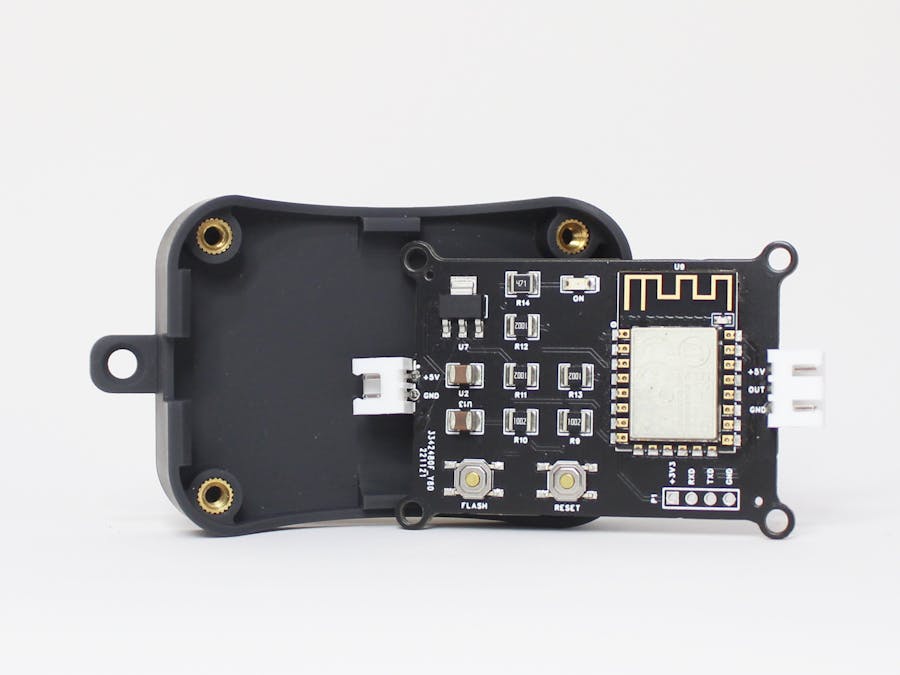Addressable RGB LEDs are devices widely used in LED arrays and strips. Among the main applications, we highlight its use in decoration of environments.
Can you imagine putting a tape or a spot with LEDs to light up a specific region of a room in your house to make it more cozy? And if you can carry out this control through your cell phone via wifi? What do you think of controlling several LED strips or matrices in a single application on your cell phone?
In this article I will teach you step by step how to build your electronic board to control addressable RGB LEDs and I will show you how we developed the complete solution for this product in China with JLCPCB.
If you want to have access to the files of this project for manufacturing the circuit board and electronic enclosure, talk to me right now on WhatsApp. I will send you quickly.
Below is the photo of the LED control device, which was manufactured at JLCPCB.
Now, let's go ahead and find out what you're going to learn while reading this article.
What will you learn in this article?Here are the main learning points:
- WiFi control circuit with the ESP8266,
- How to manufacture any electronic prototype in China,
- How to develop an addressable LED solution and control it from your mobile phone over WiFi.
First we will present the operation of the circuit and then present the tests and validation of the project.
WS2812B RGB LED Controller Electronic Circuit DesignBelow is the complete electronic schematic of the project. The project was divided into several blocks to facilitate the understanding and analysis of the circuit.
Next, we'll start with the circuit's power connector block.
WS2812B LED control and circuit power connectors and LED ON/OFF circuitThe control power circuit is 5V. The power supply is used to power the WS2812B circuit and LEDs. The circuit block is shown below.
The digital pin IO4 is used by the ESP8266 to control the WS2812B LEDs. The +5V voltage is also used to drive the ON/OFF LED. See the circuit below.
This LED is used to signal that the module circuit is powered.
The ESP8266 circuit operates with +3V3 voltage. For this reason we need a voltage regulator circuit for +3V3.
+3V3 voltage regulator circuitThe voltage regulator circuit uses the AMS1117 electronic component. It takes the input voltage of +5V and supplies a regulated voltage of +3V3 on its output.
Now, we have the ESP8266 configuration circuit.
ESP8266 Configuration CircuitThe ESP8266 is the CHIP responsible for controlling the LEDs through the commands received via WiFi from the mobile application. This CHIP needs a minimal circuit to start code execution. Below is the presentation of the circuit.
Without this circuit is the starting point for you to develop any project using the ESP8266. In addition to it, we need the programming and reset pins. These two circuits are shown below.
The circuit above is essential during the code transfer process for the ESP8266. These 2 buttons are used to place the ESP8266 in programming mode. Use a USB-TLL converter to perform computer code transfer to the ESP8266.
From this electronic schematic, we designed the layout of the printed circuit board.
The project's printed circuit board was developed and assembled at JLCPCB.
Want access to the fabrication files, component list, and 3D model of the enclosure for this project? Click this link and talk to me right now on WhatsApp and I'll send it to you.
Take advantage now and receive 5 free units of this electronic board in your home. It uses SMD electronic components, but they are all easy to solder as they are large and easy to handle during the soldering process.
Follow the video step by step and get 5 free units now.
Below we have some pictures of the printed circuit board.
From its structure, we used the Fusion 360 3D modeling software to create an electronic enclosure to store the printed circuit board.
3D Modeling of the Electronic EnclosureFrom the 3D model of the circuit board, we developed the electronic enclosure for the project. See the structure in the figure below.
After the 3D modeling, we printed the first prototype to test the fittings for mounting the electronic board and the structure's fitting cover. The pieces were printed on the Creality Ender 3 S1 Printer.
After testing and analysis, we 3D printed the enclosure using resin material with SLA technology. The resin offers a better finish and higher surface quality compared to the quality of FDM technology. Below we have some images of the enclosure printed with white and black resin material.
JLCPCB's 3D printing service with resin material offers great surface quality, as all parts are polished after the printing process. Also, improve the quality of presentation of the final prototype to the user.
After the assembly tests of the final prototype with the resin electronic enclosure, we use the WLED firmware to control the RGB LED strip.
What is WLED firmware?The WLED is a fast and feature-rich implementation of an ESP8266/ESP32 webserver to control NeoPixel (WS2812B, WS2811, SK6812) LEDs or also SPI based chipsets like the WS2801 and APA102.
With WLED you don't have to worry about creating lines of code to control your application's LEDs. The WLED has firmware and a mobile application. In a simple and easy way, you install the firmware on your ESP8266/ESP32 and, later, register the board in your application through a WiFi network scanning process.
The control application can be accessed by computer or cell phone. Below are images of the LED control interface.
Next you will learn how to install the WLED firmware.
How to install WLED on my ESP8266?To install the WLED firmware you first need to connect your control board to the computer with the aid of a USB-SERIAL converter.
After that, you must access the WLED website (Access now) and put your board in programming mode. To do so, use the Flash and Reset buttons.
Finally, follow the step by step that is presented on the WLED website, click install and wait while the code will be recorded on your device.
After transferring the code, you must enter the SSID and password of your WiFi network. That's it, the firmware is installed on your ESP8266.
Now you need to install the WLED app on your mobile. The app is available for iOS and Android.
After installing the app, follow the step by step below to scan the wifi network to register the device to your app and control it.
After installing the application, you must open it and find the first screen with no registered devices.
Click the "+" symbol to add a new device. After that, the second screen will appear and you must click on the "Discover Lights" option. Please wait while the app searches for a WLED device on your WiFi network.
After the search, the application will find your device and display the message "Found WLED", as shown in Figure 3. Click on the check symbol.
Figure 4 shows the screen with the registered device. You can click the ON/OFF button to turn the LED on and off or move the slider to control the brightness of your LED strip.
In case you want to change the color, modify animation of the LEDs and change and access the settings properties, you have to click on the WLED name.
The following screen presented above will open. It features numerous color control information, brightness and more. Through your screen you'll control your LED strip.
Next, see how the project works by controlling a decorative LED strip on our table.
Do you want to have access to the files of this electronic board and win 5 free units and receive it at your home? Follow the step by step below and earn now.
AcknowledgmentJLCPCB is a company that is concerned with technological development and is here to support you in the production of your projects.
We appreciate the support of JLCPCB for providing all the support for the production of this project.














Comments
Please log in or sign up to comment.